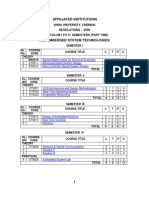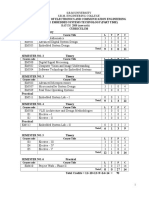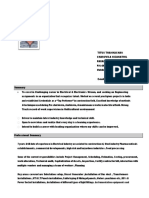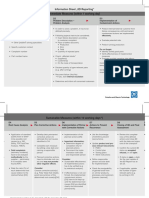Embedded
Embedded
Uploaded by
Nanc JoyCopyright:
Available Formats
Embedded
Embedded
Uploaded by
Nanc JoyCopyright
Available Formats
Share this document
Did you find this document useful?
Is this content inappropriate?
Copyright:
Available Formats
Embedded
Embedded
Uploaded by
Nanc JoyCopyright:
Available Formats
ANNA UNIVERSITY, CHENNAI AFFILIATED INSTITUTIONS
R - 2009
CURRICULUM I SEMESTER (FULL TIME)
M.E. EMBEDDED SYSTEM TECHNOLOGIES
SEMESTER I SL. COURSE No CODE THEORY MA9216 1 2 ET9211 3 ET9212 4 ET9213 5 ET9214 6 COURSE TITLE L T P C
Applied Mathematics for Electrical Engineers Advanced Digital System Design Micro Controller Based System Design Design of Embedded Systems Real Time Systems Elective I TOTAL
3 3 3 3 3 3 18
1 0 0 0 0 0 1
0 0 0 0 0 0 0
4 3 3 3 3 3 19
ELECTIVES FOR M.E EMBEDDED SYSTEM TECHNOLOGIES SEMESTER I SL. COURSE NO CODE 1 ET9251 2 3 PE9275 AP9222 COURSE TITLE Software Technology for Embedded Systems Soft Computing Techniques Computer Architecture and parallel processing L 3 3 3 T 0 0 0 P 0 0 0 C 3 3 3
MA 9216
APPLIED MATHEMATICS FOR ELECTRICAL ENGINEERS
LTPC 3104
UNIT I ADVANCED MATRIX THEORY 12 Eigen-values using QR transformations Generalized eigen vectors Canonical forms Singular value decomposition and applications Pseudo inverse Least square approximations. UNIT II LINEAR PROGRAMMING 12 Formulation Graphical Solution Simplex Method Two Phase Method Transportation and Assignment Problems. UNIT III ONE DIMENSIONAL RANDOM VARIABLES 12 Random variables - Probability function moments moment generating functions and their properties Binomial, Poisson, Geometric, Uniform, Exponential, Gamma and Normal distributions Function of a Random Variable. UNIT IV QUEUEING MODELS 12 Poisson Process Markovian queues Single and Multi Serve r Models Littles formula Machine Interference Model Steady State analysis Self Service queue. UNIT V COMPUTATIONAL METHODS IN ENGINEERING 12 Boundary value problems for ODE Finite difference methods Numerical solution of PDE Solution of Laplace and Poisson equations Liebmann's iteration process Solution of heat conduction equation by Schmidt explicit formula and Crank-Nicolson implicit scheme Solution of wave equation. L +T: 45+15 = 60 PERIODS REFERENCES 1. Bronson, R., Matrix Operation, Schaums outline series, McGraw Hill, New York, (1989). 2. Taha, H. A., Operations Research: An Introduction, Seventh Edition, Pearson Education Edition, Asia, New Delhi (2002). 3. R. E. Walpole, R. H. Myers, S. L. Myers, and K. Ye, Probability and Statistics for Engineers & Scientists, Asia, 8th Edition, (2007). 4. Donald Gross and Carl M. Harris, Fundamentals of Queueing theory, 2nd edition, John Wiley and Sons, New York (1985). 5. Grewal, B.S., Numerical methods in Engineering and Science, 7th edition, Khanna Publishers, 200
ET 9211 AIM
ADVANCED DIGITAL SYSTEM DESIGN
LTPC 3 003
To expose the students to the fundamentals of digital logic based system design. OBJECTIVES To impart knowledge on Basics on Synchronous & Async digital switching design. Design & realisation of error free functional blocks for digital systems UNIT I SEQUENTIAL CIRCUIT DESIGN 9
Analysis of Clocked Synchronous Sequential Networks (CSSN) Modelling of CSSN State Stable Assignment and Reduction Design of CSSN Design of Iterative Circuits ASM Chart ASM Realization, Design of Arithmetic circuits for Fast adder- Array Multiplier. UNIT II ASYNCHRONOUS SEQUENTIAL CIRCUIT DESIGN 9
Analysis of Asynchronous Sequential Circuit (ASC) Flow Table Reduction Races in ASC State Assignment Problem and the Transition Table Design of ASC Static and Dynamic Hazards Essential Hazards Data Synchronizers Designing Vending Machine Controller Mixed Operating Mode Asynchronous Circuits. UNIT III FAULT DIAGNOSIS AND TESTABILITY ALGORITHMS 9
Fault Table Method Path Sensitization Method Boolean Difference Method Kohavi Algorithm Tolerance Techniques The Compact Algorithm Practical PLAs Fault in PLA Test Generation Masking Cycle DFT Schemes Built-in Self Test. UNIT IV SYNCHRONOUS DESIGN USING PROGRAMMABLE DEVICES 9
Programming Techniques -Re-Programmable Devices Architecture- Function blocks, I/O blocks, Interconnects, Realize combinational, Arithmetic, Sequential Circuit with Programmable Array Logic; Architecture and application of Field Programmable Logic Sequence. UNIT V NEW GENERATION PROGRAMMABLE LOGIC DEVICES 9 Foldback Architecture with GAL, EPLD, EPLA , PEEL, PML; PROM Realization State machine using PLD FPGA Xilinx FPGA Xilinx 2000 - Xilinx 3000 TOTAL: 45 PERIODS REFERENCES 1. Donald G. Givone, Digital principles and Design, Tata McGraw Hill 2002. 2. Stephen Brown and Zvonk Vranesic, Fundamentals of Digital Logic with VHDL Deisgn, Tata McGraw Hill, 2002 3. Mark Zwolinski, Digital System Design with VHDL, Pearson Education, 2004 4. Parag K Lala, Digital System design using PLD, BS Publications, 2003 5. John M Yarbrough, Digital Logic applications and Design, Thomson Learning, 2001 6. Nripendra N Biswas, Logic Design Theory, Prentice Hall of India, 2001 7. Charles H. Roth Jr., Fundamentals of Logic design, Thomson Learning, 2004.
ET 9212
MICROCONTROLLER BASED SYSTEM DESIGN
LTPC 3003
AIM To expose the students to the fundamentals of microcontroller based system design. OBJECTIVES To impart knowledge on 8051 Microcontroller based system design. Microchip PIC 8 bit microcontroller based system Design UNIT I 8051 ARCHITECTURE 9
Architecture memory organization addressing modes instruction set Timers Interrupts - I/O ports, Interfacing I/O Devices Serial Communication. UNIT II 8051 PROGRAMMING 9 Assembly language programming Arithmetic Instructions Logical Instructions Single bit Instructions Timer Counter Programming Serial Communication Programming Interrupt Programming RTOS for 8051 RTOSLite FullRTOS Task creation and run LCD digital clock/thermometer using FullRTOS UNIT III PIC MICROCONTROLLER 9
Architecture memory organization addressing modes instruction set PIC progrmming in Assembly & C I/O port, Data Conversion, RAM & ROM Allocation, Timer programming, MP-LAB. UNIT IV PERIPHERAL OF PIC MICROCONTROLLER 9 Timers Interrupts, I/O ports- I2C bus-A/D converter-UART- CCP modules -ADC, DAC and Sensor Interfacing Flash and EEPROM memories. UNIT V SYSTEM DESIGN CASE STUDY 9
Interfacing LCD Display Keypad Interfacing - Generation of Gate signals for converters and Inverters - Motor Control Controlling AC appliances Measurement of frequency Stand alone Data Acquisition System. TOTAL: 45 PERIODS REFERENCES 1. 2. 3. Muhammad Ali Mazidi, Rolin D. Mckinlay, Danny Causey PIC Microcontroller and Embedded Systems using Assembly and C for PIC18, Pearson Education 2008 John Iovine, PIC Microcontroller Project Book , McGraw Hill 2000 Myke Predko, Programming and customizing the 8051 microcontroller, Tata McGraw Hill 2001.
ET 9213
DESIGN OF EMBEDDED SYSTEMS
LTPC 300 3
UNIT I EMBEDDED DESIGN LIFE CYCLE 9 Product specification Hardware / Software partitioning Detailed hardware and software design Integration Product testing Selection Processes Microprocessor Vs Micro Controller Performance tools Bench marking RTOS Micro Controller Performance tools Bench marking RTOS availability Tool chain availability Other issues in selection processes. UNIT II PARTITIONING DECISION 9
Hardware / Software duality coding Hardware ASIC revolution Managing the Risk Co-verification execution environment memory organization System startup Hardware manipulation memory mapped access speed and code density. UNIT III INTERRUPT SERVICE ROUTINES 9
Watch dog timers Flash Memory basic toolset Host based debugging Remote debugging ROM emulators Logic analyser Caches Computer optimisation Statistical profiling UNIT IV IN CIRCUIT EMULATORS 9
Buller proof run control Real time trace Hardware break points Overlay memory Timing constraints Usage issues Triggers. UNIT V TESTING 9
Bug tracking reduction of risks & costs Performance Unit testing Regression testing Choosing test cases Functional tests Coverage tests Testing embedded software Performance testing Maintenance. TOTAL : 45 PERIODS REFERENCES 1. Arnold S. Berger Embedded System Design, CMP books, USA 2002. 2. Sriram Iyer, Embedded Real time System Programming 3. ARKIN, R.C., Behaviour-based Robotics, The MIT Press, 1998.
ET 9214 UNIT I
REAL TIME SYSTEMS INTRODUCTION
LTPC 3003 9
Introduction Issues in Real Time Computing Structure of a Real Time System Task classes Performance Measures for Real Time Systems Estimating Program Run Times Task Assignment and Scheduling Classical uniprocessor scheduling algorithms Uniprocessor scheduling of IRIS tasks Task assignment Mode changes and Fault Tolerant Scheduling.
UNIT II
PROGRAMMING LANGUAGES AND TOOLS
Programming Languages and Tools Desired language characteristics Data typing Control structures Facilitating Hierarchical Decomposition, Packages, Run time (Exception) Error handling Overloading and Generics Multitasking Low level programming Task Scheduling Timing Specifications Programming Environments Run time support. UNIT III REAL TIME DATABASES 9
Real time Databases Basic Definition, Real time Vs General Purpose Databases, Main Memory Databases, Transaction priorities, Transaction Aborts, Concurrency control issues, Disk Scheduling Algorithms, Two phase Approach to improve Predictability Maintaining Serialization Consistency Databases for Hard Real Time Systems. UNIT IV COMMUNICATION 9
Real Time Communication Communications media, Network Topologies Protocols, Fault Tolerant Routing. Fault Tolerance Techniques Fault Types Fault Detection. Fault Error containment Redundancy Data Diversity Reversal Checks Integrated Failure handling. UNIT V EVALUATION TECHNIQUES 9
Reliability Evaluation Techniques Obtaining parameter values, Reliability models for Hardware Redundancy Software error models. Clock Synchronization Clock, A Nonfault Tolerant Synchronization Algorithm Impact of faults Fault Tolerant Synchronization in Hardware Fault Tolerant Synchronization in software. TOTAL : 45 PERIODS TEXT BOOKS 1. C.M. Krishna, Kang G. Shin, Real Time Systems, McGraw Hill International Editions, 1997. 2. Rajib Mall, Real-time systems: theory and practice, Pearson Education, 2007 3. Peter D.Lawrence, Real Time Micro Computer System Design An Introduction, McGraw Hill, 1988. 4. Stuart Bennett, Real Time Computer Control An Introduction, Prentice Hall of India, 1998. 5. S.T. Allworth and R.N.Zobel, Introduction to real time software design, Macmillan, 2nd Edition, 1987. 6. R.J.A Buhur, D.L Bailey, An Introduction to Real Time Systems, Prentice Hall International, 1999. 7. Philip.A.Laplante, Real Time System Design and Analysis, Prentice Hall of India, 3rd Edition, April 2004.
ET 9251
SOFTWARE TECHNOLOGY FOR EMBEDDED SYSTEMS
LTPC 3 003 9
UNIT I
PROGRAMMING EMBEDDED SYSTEMS
Embedded Program Role of Infinite loop Compiling, Linking and locating downloading and debugging Emulators and simulators processor External peripherals Toper of memory Memory testing Flash Memory. UNIT II C AND ASSEMBLY 9
Overview of Embedded C - Compilers and Optimization - Programming and Assembly Register usage conventions typical use of addressing options instruction sequencing procedure call and return parameter passing retrieving parameters everything in pass by value temporary variables UNIT III. EMBEDDED PROGRAM AND SOFTWARE DEVELOPMENT PROCESS 9 Program Elements Queues Stack- List and ordered lists-Embedded programming in C++ - Inline Functions and Inline Assembly - Portability Issues - Embedded JavaSoftware Development process: Analysis Design- Implementation Testing Validation- Debugging - Software maintenance UNIT IV UNIFIED MODELLING LANGUAGE 9
Object State Behaviour UML State charts Role of Scenarios in the Definition of Behaviour Timing Diagrams Sequence Diagrams Event Hierarchies Types and Strategies of Operations Architectural Design in UML Concurrency Design Representing Tasks System Task Diagram Concurrent State Diagrams Threads. Mechanistic Design Simple Patterns UNIT V WEB ARCHITECTURAL FRAMEWORK FOR EMBEDDED SYSTEM 9
Basics Client/sever model- Domain Names and IP address Internet Infrastructure and Routing URL TCP/IP protocols - Embedded as Web Client - Embedded Web servers - HTML - Web security - Case study : Web-based Home Automation system.
TOTAL : 45 PERIODS REFERENCES: 1. David E.Simon: An Embedded Software Primer, Pearson Education, 2003 2. Michael Barr, Programming Embedded Systems in C and C++, Oreilly, 2003 3. H.M. Deitel , P.J.Deitel, A.B. Golldberg Internet and World Wide Web How to Program Third Edition , Pearson Education , 2001. 4. Bruce Powel Douglas, Real-Time UML, Second Edition: Developing Efficient Object for Embedded Systems, 2nd edition ,1999, Addison-Wesley 5. Daniel W.lewis Fundamentals of Embedded Software where C and Assembly meet PHI 2002. 6. Raj Kamal, Embedded Systems- Architecture, Programming and Design Tata McGraw Hill, 2006.
PE9275
SOFT COMPUTING TECHNIQUES
LTPC 300 3 9
UNIT I
INTRODUCTION
Approaches to intelligent control. Architecture for intelligent control. Symbolic reasoning system, rule-based systems, the AI approach. Knowledge representation. Expert systems. UNIT II ARTIFICIAL NEURAL NETWORKS 9
Concept of Artificial Neural Networks and its basic mathematical model, McCulloch-Pitts neuron model, simple perceptron, Adaline and Madaline, Feed-forward Multilayer Perceptron. Learning and Training the neural network. Data Processing: Scaling, Fourier transformation, principal-component analysis and wavelet transformations. Hopfield network, Self-organizing network and Recurrent network. Neural Network based controller UNIT III FUZZY LOGIC SYSTEM 9
Introduction to crisp sets and fuzzy sets, basic fuzzy set operation and approximate reasoning. Introduction to fuzzy logic modeling and control. Fuzzification, inferencing and defuzzification. Fuzzy knowledge and rule bases. Fuzzy modeling and control schemes for nonlinear systems. Self-organizing fuzzy logic control. Fuzzy logic control for nonlinear time-delay system. UNIT IV GENETIC ALGORITHM 9
Basic concept of Genetic algorithm and detail algorithmic steps, adjustment of free parameters. Solution of typical control problems using genetic algorithm. Concept on some other search techniques like tabu search and anD-colony search techniques for solving optimization problems. UNIT V APPLICATIONS 9
GA application to power system optimisation problem, Case studies: Identification and control of linear and nonlinear dynamic systems using Matlab-Neural Network toolbox. Stability analysis of Neural-Network interconnection systems. Implementation of fuzzy logic controller using Matlab fuzzy-logic toolbox. Stability analysis of fuzzy control systems. TOTAL : 45 PERIODS REFERENCES 1. Jacek.M.Zurada, "Introduction to Artificial Neural Systems", Jaico Publishing House, 1999. 2. KOSKO,B. "Neural Networks And Fuzzy Systems", Prentice-Hall of India Pvt. Ltd., 1994. 3. KLIR G.J. & FOLGER T.A. "Fuzzy sets, uncertainty and Information", Prentice-Hall of India Pvt. Ltd., 1993. 4. Zimmerman H.J. "Fuzzy set theory-and its Applications"-Kluwer Academic Publishers, 1994. 5. Driankov, Hellendroon, "Introduction to Fuzzy Control", Narosa Publishers.
AP 9222
COMPUTER ARCHITECTURE AND PARALLEL PROCESSING
LTPC 30 03
UNIT I THEORY OF PARALLELISM 9 Parallel Computer models the state of computing, Multiprocessors and Multicomputers and Multivectors and SIMD computers, PRAM and VLSI models, Architectural development tracks, Program and network properties Conditions of parallelism. UNIT II PARTITIONING AND SCHEDULING 9 Program partitioning and scheduling, Program flow mechanisms, System interconnect architectures, Principles of scalable performance performance matrices and measures, Parallel processing applications, speedup performance laws, scalability analysis and approaches. UNIT III HARDWARE TECHNOLGIES 9 Processor and memory hierarchy advanced processor technology, superscalar and vector processors, memory hierarchy technology, virtual memory technology, bus cache and shared memory backplane bus systems, cache memory organizations, shared memory organizations, sequential and weak consistency models. UNIT IV PIPELINING AND SUPERSCALAR TECHNOLOGIES 9 Parallel and scalable architectures, Multiprocessor and Multicomputers, Multivector and SIMD computers, Scalable, Multithreaded and data flow architectures. UNIT V SOFTWARE AND PARALLEL PROCESSING 9 Parallel models, Languages and compilers, Parallel program development and environments, UNIX, MACH and OSF/1 for parallel computers. TOTAL : 45 PERIODS REFERENCES: 1. Kai Hwang Advanced Computer Architecture. McGraw Hill International 2001. 2. Dezso Sima, Terence Fountain, Peter Kacsuk, Advanced computer Architecture A design Space Approach. Pearson Education,2003. 3. Carl Homacher, Zvonko Vranesic, Sefwat Zaky, Computer Organisation, 5th Edition, TMH, 2002. 4. David E. Culler, Jaswinder Pal Singh with Anoop Gupta Parallel Computer Architecture ,Elsevier, 2004. 5. John P. Shen. Modern processor design Fundamentals of super scalar processors, Tata McGraw Hill 2003. 6. Sajjan G. Shiva Advanced Computer Architecture, Taylor & Francis, 2008. 7. V.Rajaraman, C.Siva Ram Murthy, Parallel Computers- Architecture and Programming, Prentice Hall India, 2008. 8. John L. Hennessy, David A. Petterson, Computer Architecture: A Quantitative Approach, 4th Edition, Elsevier, 2007. 9. Harry F. Jordan Gita Alaghaband, Fundamentals of Parallel Processing. Pearson Education, 2003. 10. Richard Y. Kain, Advanced computer architecture A system Design Approach, PHI, 2003.
You might also like
- Fault Tolerant & Fault Testable Hardware DesignFrom EverandFault Tolerant & Fault Testable Hardware DesignRating: 5 out of 5 stars5/5 (2)
- Computer-Controlled Systems: Theory and Design, Third EditionFrom EverandComputer-Controlled Systems: Theory and Design, Third EditionRating: 3 out of 5 stars3/5 (4)
- Engine Mechanical-Part 3Document45 pagesEngine Mechanical-Part 3Juan Camilo Chavez BolañosNo ratings yet
- M E EmbeddedSystemTechnologiesDocument31 pagesM E EmbeddedSystemTechnologiesRohini BabuNo ratings yet
- M.E.embedded System TechnologiesDocument32 pagesM.E.embedded System TechnologiesSri RamNo ratings yet
- R 2008 M.E. Embedded System Tech SyllabusDocument26 pagesR 2008 M.E. Embedded System Tech Syllabuslee_ganeshNo ratings yet
- Cse I PDFDocument22 pagesCse I PDFannamyemNo ratings yet
- Emb PT 08Document21 pagesEmb PT 08Anonymous IjquQOmNo ratings yet
- Syllabus For Applied ElectronicsDocument28 pagesSyllabus For Applied ElectronicsvinayakbondNo ratings yet
- Emb Sys TecDocument39 pagesEmb Sys TecYuvaperiyasamy MayilsamyNo ratings yet
- I M.Tech - IT (Full Time) (11-13)Document8 pagesI M.Tech - IT (Full Time) (11-13)Balaji PaulrajNo ratings yet
- CSEDocument6 pagesCSEstaalinNo ratings yet
- Regulations - 2009: Affiliated Institutions Anna University, ChennaiDocument10 pagesRegulations - 2009: Affiliated Institutions Anna University, Chennaisri_vas00074013No ratings yet
- M.E Cse PDFDocument51 pagesM.E Cse PDFLatha MugunthanNo ratings yet
- Software For Embedded SystemDocument39 pagesSoftware For Embedded Systemjani28cseNo ratings yet
- Me Eee Es R13Document42 pagesMe Eee Es R13Revathy VijayanNo ratings yet
- Cse Syllabus R 2009Document87 pagesCse Syllabus R 2009MATHANKUMAR.SNo ratings yet
- Cs 41 Design and Analysis of Algorithms 3 1 0 4Document14 pagesCs 41 Design and Analysis of Algorithms 3 1 0 4Ajmal KhanNo ratings yet
- Anna University Chennai:: Chennai 600 025 Affiliated Institutions Curriculum 2008 B.E. Computer Science and EngineeringDocument11 pagesAnna University Chennai:: Chennai 600 025 Affiliated Institutions Curriculum 2008 B.E. Computer Science and EngineeringDaniel MariadassNo ratings yet
- CseDocument31 pagesCsepradeep_dgsNo ratings yet
- Sem 4Document12 pagesSem 4RajaRaman.GNo ratings yet
- SyllabusDocument5 pagesSyllabusKakashiGanzNo ratings yet
- Ma 2262 Probability and Queueing Theory 3 1 0 4Document8 pagesMa 2262 Probability and Queueing Theory 3 1 0 4karthickpsvNo ratings yet
- Regulation - 2009: Affiliated Institutions Anna University, ChennaiDocument27 pagesRegulation - 2009: Affiliated Institutions Anna University, ChennaiYogeswaran SundarrajNo ratings yet
- Computer ScienceDocument58 pagesComputer SciencepajadhavNo ratings yet
- 2nd Sem SyllabusDocument6 pages2nd Sem SyllabusAnandi VenougopalNo ratings yet
- National Engineering College: Regulations - 2011Document73 pagesNational Engineering College: Regulations - 2011Stanly JonesNo ratings yet
- MCADocument63 pagesMCAarul07097265No ratings yet
- CSE 5th SemDocument12 pagesCSE 5th SemkartamdNo ratings yet
- UntitledDocument12 pagesUntitledSathiyaraj MurugarajNo ratings yet
- Ae IIDocument27 pagesAe IIAnbu SelvanNo ratings yet
- Embedded System TechnologiesDocument37 pagesEmbedded System TechnologiesjayaprahasNo ratings yet
- Embedded Systems Syllabus PSGDocument15 pagesEmbedded Systems Syllabus PSGkumaranrajNo ratings yet
- MR3391 SyllabusDocument1 pageMR3391 Syllabusadmission1.gojanNo ratings yet
- Regulations - 2009: Affiliated Institutions Anna University, ChennaiDocument44 pagesRegulations - 2009: Affiliated Institutions Anna University, ChennaiThenmozhi RavichandranNo ratings yet
- M.E. (Embedded System Technologies)Document37 pagesM.E. (Embedded System Technologies)Priya DarshiniNo ratings yet
- Sl. No Course Code Course Title Category Contact Periods L T P C TheoryDocument10 pagesSl. No Course Code Course Title Category Contact Periods L T P C TheoryVani RajasekharNo ratings yet
- MCA Syllabus Regulation 2009 Anna UniversityDocument61 pagesMCA Syllabus Regulation 2009 Anna UniversityJGPORGNo ratings yet
- Introduction to Quantum Computing & Machine Learning Technologies: 1, #1From EverandIntroduction to Quantum Computing & Machine Learning Technologies: 1, #1No ratings yet
- Performance Evaluation by Simulation and Analysis with Applications to Computer NetworksFrom EverandPerformance Evaluation by Simulation and Analysis with Applications to Computer NetworksNo ratings yet
- Models and Analysis for Distributed SystemsFrom EverandModels and Analysis for Distributed SystemsSerge HaddadNo ratings yet
- Design Automation of Cyber-Physical SystemsFrom EverandDesign Automation of Cyber-Physical SystemsMohammad Abdullah Al FaruqueNo ratings yet
- Embedded Systems: Analysis and Modeling with SysML, UML and AADLFrom EverandEmbedded Systems: Analysis and Modeling with SysML, UML and AADLFabrice KordonNo ratings yet
- Programming Multicore and Many-core Computing SystemsFrom EverandProgramming Multicore and Many-core Computing SystemsSabri PllanaNo ratings yet
- Pipelined Processor Farms: Structured Design for Embedded Parallel SystemsFrom EverandPipelined Processor Farms: Structured Design for Embedded Parallel SystemsNo ratings yet
- Introduction to Digital Systems: Modeling, Synthesis, and Simulation Using VHDLFrom EverandIntroduction to Digital Systems: Modeling, Synthesis, and Simulation Using VHDLNo ratings yet
- Material-Integrated Intelligent Systems: Technology and ApplicationsFrom EverandMaterial-Integrated Intelligent Systems: Technology and ApplicationsStefan BosseNo ratings yet
- DATA MINING and MACHINE LEARNING. CLASSIFICATION PREDICTIVE TECHNIQUES: NAIVE BAYES, NEAREST NEIGHBORS and NEURAL NETWORKS: Examples with MATLABFrom EverandDATA MINING and MACHINE LEARNING. CLASSIFICATION PREDICTIVE TECHNIQUES: NAIVE BAYES, NEAREST NEIGHBORS and NEURAL NETWORKS: Examples with MATLABNo ratings yet
- Mivar NETs and logical inference with the linear complexityFrom EverandMivar NETs and logical inference with the linear complexityNo ratings yet
- Computer Science: The Complete Guide to Principles and InformaticsFrom EverandComputer Science: The Complete Guide to Principles and InformaticsNo ratings yet
- Computer Skills: Understanding Computer Science and Cyber Security (2 in 1)From EverandComputer Skills: Understanding Computer Science and Cyber Security (2 in 1)No ratings yet
- Using Artificial Neural Networks for Analog Integrated Circuit Design AutomationFrom EverandUsing Artificial Neural Networks for Analog Integrated Circuit Design AutomationNo ratings yet
- Embedded Systems Programming with C++: Real-World TechniquesFrom EverandEmbedded Systems Programming with C++: Real-World TechniquesNo ratings yet
- Quantization Methods for Large Language Models From Theory to Real-World ImplementationsFrom EverandQuantization Methods for Large Language Models From Theory to Real-World ImplementationsNo ratings yet
- Advances in Motion Sensing and Control for Robotic Applications: Selected Papers from the Symposium on Mechatronics, Robotics, and Control (SMRC’18)- CSME International Congress 2018, May 27-30, 2018 Toronto, CanadaFrom EverandAdvances in Motion Sensing and Control for Robotic Applications: Selected Papers from the Symposium on Mechatronics, Robotics, and Control (SMRC’18)- CSME International Congress 2018, May 27-30, 2018 Toronto, CanadaFarrokh Janabi-SharifiNo ratings yet
- Is Matter Around Us Pure by K C HUBBALLIDocument35 pagesIs Matter Around Us Pure by K C HUBBALLINanc JoyNo ratings yet
- Ge6075 2m Rejinpaul IIDocument16 pagesGe6075 2m Rejinpaul IINanc JoyNo ratings yet
- Characterization and Identification of Surface Imperfections in FSW Using Image Processing ApproachDocument1 pageCharacterization and Identification of Surface Imperfections in FSW Using Image Processing ApproachNanc JoyNo ratings yet
- Ec2301 Digital CommunicationDocument2 pagesEc2301 Digital CommunicationNanc JoyNo ratings yet
- 1-Pom 2m - With AnsDocument0 pages1-Pom 2m - With AnsNanc JoyNo ratings yet
- Word of The End Times. English Ver3Document2 pagesWord of The End Times. English Ver3Nanc JoyNo ratings yet
- MIS - WUA Lecture Notes 1Document13 pagesMIS - WUA Lecture Notes 1Anesu FreddyNo ratings yet
- EK-i EW-i: Compact BalancesDocument4 pagesEK-i EW-i: Compact Balancessiri.ketarachNo ratings yet
- Propeller Owner's Manual: and LogbookDocument176 pagesPropeller Owner's Manual: and LogbookThania Karina Flores Carvajal.No ratings yet
- Led ControlDocument43 pagesLed ControlJunior GodoiNo ratings yet
- Ripon Electric Not SR ItemsDocument3 pagesRipon Electric Not SR Items24ZM-Speed- ElyasNo ratings yet
- Deployment Guidelines For CDGC, CDQ, CDP, and CDMPDocument75 pagesDeployment Guidelines For CDGC, CDQ, CDP, and CDMPOrachai TassanamethinNo ratings yet
- Service Manual Aire Central Lg. Ln-C0602sa0 PDFDocument31 pagesService Manual Aire Central Lg. Ln-C0602sa0 PDFFreddy Enrique Luna MirabalNo ratings yet
- Intranet PDFDocument17 pagesIntranet PDFMavura Michael MgayaNo ratings yet
- Electric Machine Lab 5Document19 pagesElectric Machine Lab 5NiTrO jOk3RNo ratings yet
- User ExitDocument62 pagesUser ExitPradeep SelokarNo ratings yet
- Webex Product Comparison Table: Webex Teams Webex Meetings Webex Events Webex Training Cisco Webex SupportDocument4 pagesWebex Product Comparison Table: Webex Teams Webex Meetings Webex Events Webex Training Cisco Webex SupportOps Traffic DigitalNo ratings yet
- 5 LS6 DL Create New Document Based On The Different Available TemplatesDocument10 pages5 LS6 DL Create New Document Based On The Different Available TemplatesjosefadrilanNo ratings yet
- Asynchronous Transfer ModeDocument37 pagesAsynchronous Transfer ModeMehboob KhokharNo ratings yet
- Motor Starting CasestudyDocument2 pagesMotor Starting Casestudykajale_shrikant2325No ratings yet
- 5 Stages in The Design Thinking Process - Interaction Design FoundationDocument6 pages5 Stages in The Design Thinking Process - Interaction Design FoundationGaneshNo ratings yet
- PMP Chapter 1 - 1Document13 pagesPMP Chapter 1 - 1aminNo ratings yet
- VPN Comparison - SimpleDocument3 pagesVPN Comparison - SimpleProfarisNo ratings yet
- Reactor - BLKMARKET©Document1 pageReactor - BLKMARKET©pentoelghoib69No ratings yet
- Clustering HiveMQDocument7 pagesClustering HiveMQlaliaga30No ratings yet
- Alcatel 2G-BSS-GsmDocument163 pagesAlcatel 2G-BSS-GsmJacky LeeNo ratings yet
- Titus Thankachan 2018 Biodata PDFDocument5 pagesTitus Thankachan 2018 Biodata PDFTitus ThankachanNo ratings yet
- Windows Desktop Operating SystemsDocument8 pagesWindows Desktop Operating SystemsRodrigoNo ratings yet
- AWS EC2 QuizDocument7 pagesAWS EC2 QuizsrihbkpNo ratings yet
- Euromap 12 PDFDocument2 pagesEuromap 12 PDFBruce0% (1)
- 4chan Presentation - Edt 180 3Document11 pages4chan Presentation - Edt 180 3api-378212842No ratings yet
- 01 - 8051 IO Ports in CDocument23 pages01 - 8051 IO Ports in Catiqakbar1No ratings yet
- Chapter 8 Spread Footings SynthesisDocument19 pagesChapter 8 Spread Footings SynthesispkNo ratings yet
- Immediate Measures (Within 1 Working Day) Information Sheet 8D-Reporting" Immediate Measures (Within 1 Working Day) Information Sheet 8D-Reporting"Document2 pagesImmediate Measures (Within 1 Working Day) Information Sheet 8D-Reporting" Immediate Measures (Within 1 Working Day) Information Sheet 8D-Reporting"trungNo ratings yet
- Troubleshooting Linear Power Supply Was Quite EasyDocument2 pagesTroubleshooting Linear Power Supply Was Quite EasyNAYEEMNo ratings yet































































































